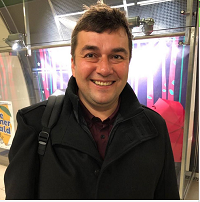- Speaker
- Prof. Maxim F. Gelin
- Hangzhou Dianzi University
- Abstract
I will give a brief overview of two recently developed simulation methods, (i) Doorway-Window (DW) method for the on-the-fly simulation of femtosecond signals of molecular species and (ii) thermo-field dynamics (TFD) tensor-train (TT) method for the simulation of dynamics and spectroscopic signals of multidimensional quantum systems.
(i) We have developed an ab initio theoretical framework for the simulation of femtosecond time-resolved transient-absorption (TA) pump-probe (PP) [1] and electronic 2D [2] spectra with quasi-classical trajectories. The simulation protocol is based on the classical approximation to the DW representation of third-order four-wave-mixing signals. The DW formulas account for the finite duration and spectral shape of the laser pulses involved. In the classical DW formalism, classical trajectories are stochastically sampled from the ground-state Wigner distribution and spectroscopic signals are evaluated by averaging the DW formulas over classical trajectories. Nonadiabatic excited-state dynamics is described by a stochastic surface-hopping algorithm. The methodology is illustrated by ab initio simulations of the ground-state bleach, stimulated emission and excited-state absorption contributions to the TA PP and 2D spectra of gas-phase pyrazine. It is demonstrated that TA PP and notably 2D spectroscopy with sub-fs UV pulses can provide unprecedentedly detailed information on the ultrafast photodynamics of polyatomic molecules.
(ii) We have elaborated a fully quantum, numerically accurate wave function-based approach for the calculation of third-order spectroscopic signals of polyatomic molecules and molecular aggregates at finite temperature [3, 4]. The systems are described by multimode nonadiabatic vibronic-coupling or excitonic Hamiltonians, in which diagonal terms are treated in harmonic approximation, while off-diagonal interstate couplings may be coordinate-dependent. The approach is based on the TFD representation of quantum mechanics and TT machinery for efficient numerical simulation of quantum evolution of systems with many degrees of freedom. Application of the developed TFD-TT approach is illustrated by the calculation of time- and frequency-resolved fluorescence spectra of the Fenna–Matthews–Olson (FMO) antenna complex at room temperature taking into account finite time-frequency resolution in fluorescence detection, orientational averaging, and static disorder.
[1] Gelin, M. F.; Huang, X.; Xie, W.; Chen, L.; Došlić, N.; Domcke, W. Ab Initio Surface-Hopping Simulation of Femtosecond Transient-Absorption Pump–Probe Signals of Nonadiabatic Excited-State Dynamics Using the Doorway–Window Representation. J. Chem. Theory Comput. 2021, https://doi.org/10.1021/acs.jctc.1c00109
[2] Gelin, M. F.; Huang, X.; Xie, W.; Došlić, N.; Domcke, W. Ab Initio Quasiclassical Simulation of Femtosecond Time-Resolved Two-Dimensional Electronic Spectra of Pyrazine. J. Phys. Chem. Lett. 2021, https://doi.org/ 10.1021/acs.jpclett.1c03589
[3] Borrelli, R.; Gelin, M. F. Finite temperature quantum dynamics of complex systems: Integrating thermo-field theories and tensor-train methods. WIREs Comput Mol Sci. 2021, https://doi.org/10.1002/wcms.1539
[4] Gelin, M. F.; Borrelli, R. Simulation of Nonlinear Femtosecond Signals at Finite Temperature via a Thermo Field Dynamics-Tensor Train Method: General Theory and Application to Time- and Frequency-Resolved Fluorescence of the Fenna–Matthews–Olson Complex. J. Chem. Theory Comput. 2021, https://doi.org/10.1021/acs.jctc.1c00158
- About the Speaker
Maxim F. Gelin received his PhD from the Institute of Physics of the National Academy of Science of Belarus in 1995. In 2002-2003, he got Alexander von Humboldt fellowship and moved to the Technical University of Munich (Germany). In 2004-2007, he worked as a research scientist at the University of Maryland in College Park (USA). In 2008, he returned to the Technical University of Munich, where he worked till 2019 as a senior research scientist at the DFG Cluster of excellence Munich Advanced Photonics (MAP). In December 2019, he joined Hangzhou Dianzi University (China). Maxim F. Gelin is an expert in theoretical femtosecond nonlinear spectroscopy, quantum dynamics, and non-equilibrium statistical mechanics.
- Date&Time
- 2023-07-21 10:00 AM
- Location
- Room: A203 Meeting Room




